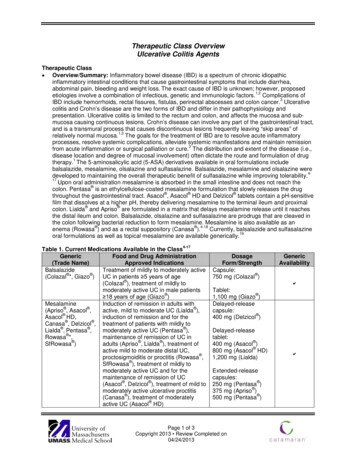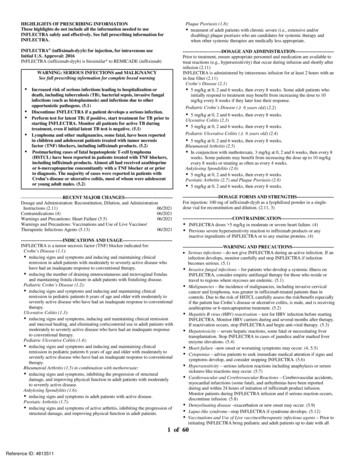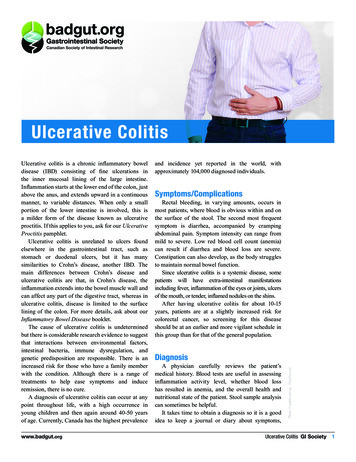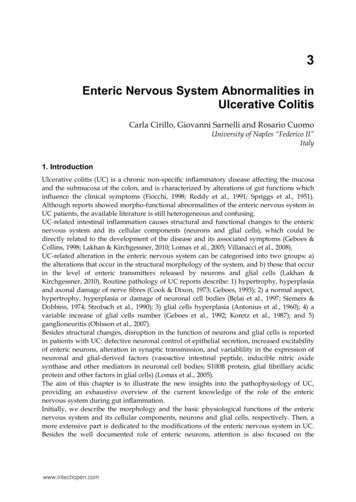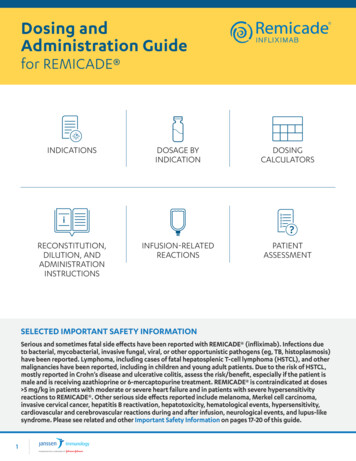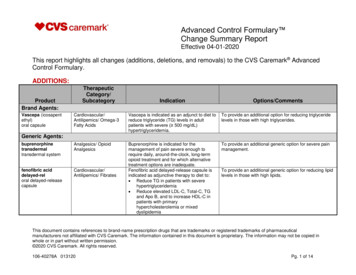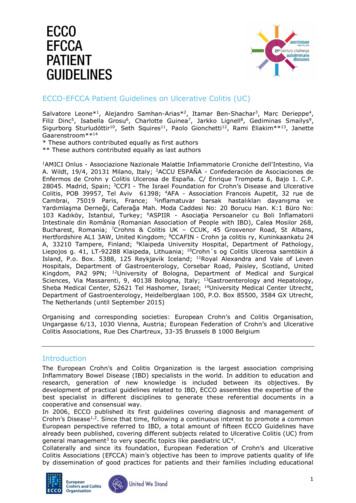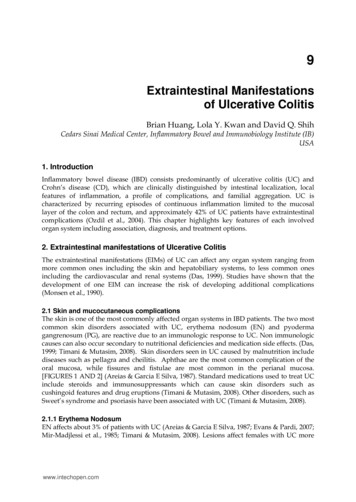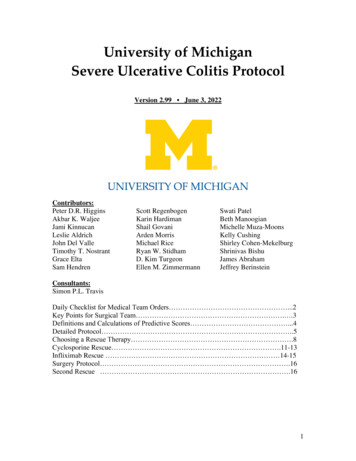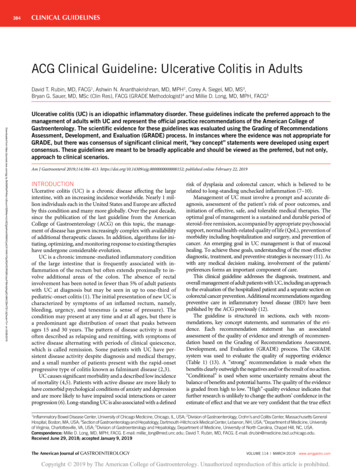
Transcription
384CLINICAL GUIDELINESACG Clinical Guideline: Ulcerative Colitis in AdultsDavid T. Rubin, MD, FACG1, Ashwin N. Ananthakrishnan, MD, MPH2, Corey A. Siegel, MD, MS3,Bryan G. Sauer, MD, MSc (Clin Res), FACG (GRADE Methodologist)4 and Millie D. Long, MD, MPH, FACG5Downloaded from https://journals.lww.com/ajg by BhDMf5ePHKav1zEoum1tQfN4a rnhjhkg0Cnl84CZ9mTZr1JijOwub Tc on 03/06/2019Ulcerative colitis (UC) is an idiopathic inflammatory disorder. These guidelines indicate the preferred approach to themanagement of adults with UC and represent the official practice recommendations of the American College ofGastroenterology. The scientific evidence for these guidelines was evaluated using the Grading of RecommendationsAssessment, Development, and Evaluation (GRADE) process. In instances where the evidence was not appropriate forGRADE, but there was consensus of significant clinical merit, “key concept” statements were developed using expertconsensus. These guidelines are meant to be broadly applicable and should be viewed as the preferred, but not only,approach to clinical scenarios.Am J Gastroenterol 2019;114:384–413. https://doi.org/10.14309/ajg.0000000000000152; published online February 22, 2019INTRODUCTIONUlcerative colitis (UC) is a chronic disease affecting the largeintestine, with an increasing incidence worldwide. Nearly 1 million individuals each in the United States and Europe are affectedby this condition and many more globally. Over the past decade,since the publication of the last guideline from the AmericanCollege of Gastroenterology (ACG) on this topic, the management of disease has grown increasingly complex with availabilityof additional therapeutic classes. In addition, algorithms for initiating, optimizing, and monitoring response to existing therapieshave undergone considerable evolution.UC is a chronic immune-mediated inflammatory conditionof the large intestine that is frequently associated with inflammation of the rectum but often extends proximally to involve additional areas of the colon. The absence of rectalinvolvement has been noted in fewer than 5% of adult patientswith UC at diagnosis but may be seen in up to one-third ofpediatric-onset colitis (1). The initial presentation of new UC ischaracterized by symptoms of an inflamed rectum, namely,bleeding, urgency, and tenesmus (a sense of pressure). Thecondition may present at any time and at all ages, but there isa predominant age distribution of onset that peaks betweenages 15 and 30 years. The pattern of disease activity is mostoften described as relapsing and remitting, with symptoms ofactive disease alternating with periods of clinical quiescence,which is called remission. Some patients with UC have persistent disease activity despite diagnosis and medical therapy,and a small number of patients present with the rapid-onsetprogressive type of colitis known as fulminant disease (2,3).UC causes significant morbidity and a described low incidenceof mortality (4,5). Patients with active disease are more likely tohave comorbid psychological conditions of anxiety and depressionand are more likely to have impaired social interactions or careerprogression (6). Long-standing UC is also associated with a definedrisk of dysplasia and colorectal cancer, which is believed to berelated to long-standing unchecked inflammation (7–10).Management of UC must involve a prompt and accurate diagnosis, assessment of the patient’s risk of poor outcomes, andinitiation of effective, safe, and tolerable medical therapies. Theoptimal goal of management is a sustained and durable period ofsteroid-free remission, accompanied by appropriate psychosocialsupport, normal health-related quality of life (QoL), prevention ofmorbidity including hospitalization and surgery, and prevention ofcancer. An emerging goal in UC management is that of mucosalhealing. To achieve these goals, understanding of the most effectivediagnostic, treatment, and preventive strategies is necessary (11). Aswith any medical decision making, involvement of the patients’preferences forms an important component of care.This clinical guideline addresses the diagnosis, treatment, andoverall management of adult patients with UC, including an approachto the evaluation of the hospitalized patient and a separate section oncolorectal cancer prevention. Additional recommendations regardingpreventive care in inflammatory bowel disease (IBD) have beenpublished by the ACG previously (12).The guideline is structured in sections, each with recommendations, key concept statements, and summaries of the evidence. Each recommendation statement has an associatedassessment of the quality of evidence and strength of recommendation based on the Grading of Recommendations Assessment,Development, and Evaluation (GRADE) process. The GRADEsystem was used to evaluate the quality of supporting evidence(Table 1) (13). A “strong” recommendation is made when thebenefits clearly outweigh the negatives and/or the result of no action.“Conditional” is used when some uncertainty remains about thebalance of benefits and potential harms. The quality of the evidenceis graded from high to low. “High”-quality evidence indicates thatfurther research is unlikely to change the authors’ confidence in theestimate of effect and that we are very confident that the true effect1Inflammatory Bowel Disease Center, University of Chicago Medicine, Chicago, IL, USA; 2Division of Gastroenterology, Crohn’s and Colitis Center, Massachusetts GeneralHospital, Boston, MA, USA; 3Section of Gastroenterology and Hepatology, Dartmouth-Hitchcock Medical Center, Lebanon, NH, USA; 4Department of Medicine, Universityof Virginia, Charlottesville, VA, USA; 5Division of Gastroenterology and Hepatology, Department of Medicine, University of North Carolina, Chapel Hill, NC, USA.Correspondence: Millie D. Long, MD, MPH, FACG. E-mail: millie long@med.unc.edu; David T. Rubin, MD, FACG. E-mail: drubin@medicine.bsd.uchicago.edu.Received June 29, 2018; accepted January 9, 2019The American Journal of GASTROENTEROLOGYVOLUME 114 MARCH 2019 www.amjgastro.comCopyright 2019 by The American College of Gastroenterology. Unauthorized reproduction of this article is prohibited.
UC in Adultslies close to that of the estimate of the effect. “Moderate”-qualityevidence is associated with moderate confidence in the effect estimate, although further research would be likely to have an impacton the confidence of the estimate, whereas “low”-quality evidenceindicates that further study would likely have an important impacton the confidence in the estimate of the effect and would likelychange the estimate. “Very low”–quality evidence indicates verylittle confidence in the effect estimate and that the true effect is likelyto be substantially different than the estimate of effect.Key concepts are statements that are not amenable to theGRADE process, either because of the structure of the statement or because of the available evidence. In some instances,key concepts are based on extrapolation of evidence and/orexpert opinion.Tables 2 and 3 summarize the GRADED recommendationsand key concept statements in this guideline.5. If the terminal ileum is normal, further evaluation of the stomachand small bowel by upper endoscopy and cross-sectional imagingis not needed unless there are other symptoms or findings tosuggest proximal GI involvement or a diagnosis of Crohn’s disease(CD) rather than UC.6. Definitions of disease severity are needed to guide treatmentdecisions; definitions should be based on (i) patient-reportedoutcomes (PROs) (bleeding and normalization of bowel habits),(ii) inflammatory burden (endoscopic assessment includingextent and severity and markers of inflammation), (iii) diseasecourse (need for hospitalization, need for steroids, and failure torespond to medications), and (iv) disease impact (functionalityand QoL).7. Fecal calprotectin (FC) can be used in patients with UC asa noninvasive marker of disease activity and to assess response totherapy and relapse.RecommendationsDIAGNOSIS, ASSESSMENT, AND PROGNOSIS OFULCERATIVE COLITISKey concept statements1. The diagnosis of UC should be suspected in patients withhematochezia and urgency.2. Infectious etiologies should be excluded at the time of diagnosis.3. Colonoscopy with intubation of the ileum and biopsies of affectedand unaffected areas should be obtained to confirm the diagnosisof UC by a trained pathologist with expertise in gastrointestinalpathology when possible.4. Categories of disease extent include (i) proctitis (within 18 cmof the anal verge, distal to the rectosigmoid junction), (ii) leftsided colitis (extending from the sigmoid to the splenic flexure),and (iii) extensive colitis (beyond the splenic flexure).1. We recommend stool testing to rule out Clostridioides difficile(C. diff) in patients suspected of having UC (strongrecommendation, very low quality of evidence).2. We recommend against serologic antibody testing to establish orrule out a diagnosis of UC (strong recommendation, very low qualityof evidence).3. We recommend against serologic antibody testing to determine theprognosis of UC (strong recommendation, very low quality ofevidence).Summary of evidenceSymptoms of bloody diarrhea, mucous, urgency, tenesmus, and abdominal cramping should triggerconsideration of a UC diagnosis, particularly in the absence of analternate cause. A full clinical history should include assessmentTable 1. Quality assessment criteriaaStudy designQuality of evidenceRandomized trialHighModerateLower ifRisk of biasHigher ifLarge effect21 serious11 large22 very serious12 very largeInconsistency21 seriousDose-response11 evidence of a gradient22 very seriousIndirectnessObservational trialLowAll plausible confounding21 serious11 would reduce a demonstrated effect or22 very serious11 would suggest a spurious effect whenresults show no effectImprecision21 serious22 very seriousVery lowPublication bias21 likely22 very likelyaSee Reference 13. 2019 by The American College of GastroenterologyThe American Journal of GASTROENTEROLOGYCopyright 2019 by The American College of Gastroenterology. Unauthorized reproduction of this article is prohibited.385
386Rubin et al.Table 2. Summary and strength of GRADED recommendations for the management of ulcerative colitisDiagnosis, assessment, and prognosis of ulcerative colitis1. We recommend stool testing to rule out Clostridioides difficile in patients suspected of having UC (strong recommendation, very low quality of evidence).2. We recommend against serologic antibody testing to establish or rule out a diagnosis of UC (strong recommendation, very low quality of evidence).3. We recommend against serologic antibody testing to determine the prognosis of UC (strong recommendation, very low quality of evidence).Goals for managing patients with ulcerative colitis4. We suggest treating patients with UC to achieve mucosal healing (defined as resolution of inflammatory changes (Mayo endoscopic subscore 0 or 1)) toincrease the likelihood of sustained steroid-free remission and prevent hospitalizations and surgery (conditional recommendation, low quality of evidence).5. We suggest FC as a surrogate for endoscopy when endoscopy is not feasible or available to assess for mucosal healing (conditional recommendation, very lowquality of evidence).Induction of remission in mildly active ulcerative colitis6. In patients with mildly active ulcerative proctitis, we recommend rectal 5-ASA therapies at a dose of 1 g/d for induction of remission (strong recommendation,high quality evidence).7. In patients with mildly active left-sided colitis, we recommend rectal 5-ASA enemas at a dose of at least 1 g/d preferred over rectal steroids for induction ofremission (strong recommendation, moderate quality of evidence).8. In patients with mildly active left-sided UC, we suggest rectal 5-ASA enemas at a dose of at least 1 g/d combined with oral 5-ASA at a dose of at least2 g/d compared with oral 5-ASA therapy alone for induction of remission (conditional recommendation, low quality of evidence).9. In patients with mildly active left-sided UC who are intolerant or nonresponsive to oral and rectal 5-ASA at appropriate doses (oral at least 2 g/d and rectal atleast 1 g/d), we recommend oral budesonide MMX 9 mg/d for induction of remission (strong recommendation, moderate quality of evidence).10. In patients with mildly active extensive colitis, oral 5-ASA at a dose of at least 2 g/d is recommended to induce remission (strong recommendation, moderatequality of evidence).11. In patients with UC of any extent who fail to respond to 5-ASA therapy, we recommend oral systemic corticosteroids to induce remission (strongrecommendation, low quality of evidence).12. In patients with mildly active UC who fail to reach remission with appropriately dosed 5-ASA (at least 2 g/d oral 5-ASA and/or at least 1 g/d rectal 5-ASA), wesuggest against changing to an alternate 5-ASA formulation to induce remission. Alternative therapeutic classes should be considered (conditionalrecommendation, low quality of evidence).13. In patients with mildly active UC of any extent, we suggest using a low dose (2–2.4 g/d) of 5-ASA compared with a higher dose (4.8 g/d), as there is nodifference in the remission rate (conditional recommendation, very low quality of evidence).14. In patients with mildly to moderately active UC not responding to oral 5-ASA, we recommend the addition of budesonide MMX 9 mg/d to induce remission(strong recommendation, moderate quality of evidence).15. In patients with mildly to moderately active UC of any extent using 5-ASA to induce remission, we recommend either once-daily or more frequently dosed oral5-ASA based on patient preference to optimize adherence, as efficacy and safety are no different (strong recommendation, moderate quality evidence).Maintenance of remission in patients with previously mildly active ulcerative colitis16. In patients with mildly active ulcerative proctitis, we recommend rectal 5-ASA at a dose of 1 g/d to maintain remission (strong recommendation, moderatequality of evidence).17. In patients with mildly active left-sided or extensive UC, we recommend oral 5-ASA therapy (at least 2 g/d) for maintenance of remission (strongrecommendation, moderate quality of evidence).18. We recommend against systemic corticosteroids for maintenance of remission in patients with UC (strong recommendation, moderate quality of evidence).Induction of remission in moderately to severely active ulcerative colitis19. In patients with moderately active UC, we recommend oral budesonide MMX for induction of remission (strong recommendation, moderate quality ofevidence).20. In patients with moderately to severely active UC of any extent, we recommend oral systemic corticosteroids to induce remission (strong recommendation,moderate quality of evidence).21. In patients with moderately to severely active UC, we recommend against monotherapy with thiopurines or methotrexate for induction of remission (strongrecommendation, low quality of evidence).22. In patients with moderately to severely active UC, we recommend anti-TNF therapy using adalimumab, golimumab, or infliximab for induction of remission(strong recommendation, high quality of evidence).23. In patients with moderately to severely active UC who have failed 5-ASA therapy and in whom anti-TNF therapy is used for induction of remission, we suggestagainst using 5-ASA for added clinical efficacy (conditional recommendation, low quality of evidence).24. When infliximab is used as induction therapy for patients with moderately to severely active UC, we recommend combination therapy with a thiopurine(strong recommendation, moderate quality of evidence for azathioprine).The American Journal of GASTROENTEROLOGYVOLUME 114 MARCH 2019 www.amjgastro.comCopyright 2019 by The American College of Gastroenterology. Unauthorized reproduction of this article is prohibited.
UC in AdultsTable 2. (continued)25. In patients with moderately to severely active UC, we recommend vedolizumab for induction of remission (strong recommendation, moderate quality ofevidence).26. In patients with moderately to severely active UC who have previously failed anti-TNF therapy, we recommend vedolizumab for induction of remission (strongrecommendation, moderate quality of evidence).27. In patients with moderately to severely active UC, we recommend tofacitinib 10 mg orally b.i.d. for 8 wk to induce remission (strong recommendation,moderate quality of evidence).28. In patients with moderately to severely active UC who have previously failed anti-TNF therapy, we recommend tofacitinib for induction of remission (strongrecommendation, moderate quality of evidence).29. In patients with moderately to severely active UC who are responders to anti-TNF therapy and now losing response, we suggest measuring serum drug levelsand antibodies (if there is not a therapeutic level) to assess the reason for loss of response (conditional recommendation, very low quality of evidence).Maintenance of remission in patients with previously moderately to severely active ulcerative colitis30. In patients with previously moderately to severely active UC who have achieved remission but previously failed 5-ASA therapy and are now on anti-TNF therapy,we recommend against using concomitant 5-ASA for efficacy of maintenance of remission (conditional recommendation, low quality of evidence).31. We recommend against systemic corticosteroids for maintenance of remission in patients with UC (strong recommendation, moderate quality of evidence).32. For patients with previously moderately to severely active UC now in remission due to corticosteroid induction, we suggest thiopurines for maintenance ofremission compared with no treatment or corticosteroids (conditional recommendation, low quality of evidence).33. In patients with previously moderately to severely active UC now in remission, we recommend against using methotrexate for maintenance of remission(conditional recommendation, low quality of evidence).34. We recommend continuing anti-TNF therapy using adalimumab, golimumab, or infliximab to maintain remission after anti-TNF induction in patients withpreviously moderately to severely active UC (strong recommendation, moderate quality of evidence).35. We recommend continuing vedolizumab to maintain remission in patients with previously moderately to severely active UC now in remission aftervedolizumab induction (strong recommendation, moderate quality of evidence).36. We recommend continuing tofacitinib for maintenance of remission in patients with previously moderately to severely active UC now in remission afterinduction with tofacitinib (strong recommendation, moderate quality of evidence).Management of the hospitalized patient with acute severe ulcerative colitis37. In patients with ASUC, we recommend DVT prophylaxis to prevent VTE (strong recommendation, low quality of evidence).38. In patients with ASUC, we recommend testing for CDI (strong recommendation, moderate quality of evidence).39. In patients with ASUC and concomitant CDI, we recommend treatment of CDI with vancomycin instead of metronidazole (strong recommendation, lowquality of evidence).40. We recommend against the routine use of broad-spectrum antibiotics in the management of ASUC (strong recommendation, low quality of evidence).41. We suggest against total parenteral nutrition for the purpose of bowel rest in ASUC (conditional recommendation, very low quality of evidence).42. In patients with ASUC, we recommend a total of 60 mg/d of methylprednisolone or hydrocortisone 100 mg 3 or 4 times per day to induce remission (strongrecommendation, low quality of evidence).43. In patients with ASUC failing to adequately respond to intravenous corticosteroids by 3–5 days we recommend medical rescue therapy with infliximab orcyclosporine (strong recommendation, moderate quality of evidence).44. In patients with ASUC who achieve remission with infliximab treatment, we recommend maintenance of remission with the same agent (strongrecommendation, moderate quality of evidence).45. In patients with ASUC who achieve remission with cyclosporine treatment, we suggest maintenance of remission with thiopurines (conditionalrecommendation, low quality of evidence).46. In patients with ASUC who achieve remission with cyclosporine treatment, we suggest maintenance of remission with vedolizumab (conditionalrecommendation, very low quality of evidence).Colorectal cancer prevention in ulcerative colitis47. We suggest colonoscopic screening and surveillance to identify neoplasia in patients with UC of any extent beyond the rectum (conditionalrecommendation, very low quality of evidence).48. When using standard-definition colonoscopes in patients with UC undergoing surveillance, we recommend dye spray chromoendoscopy with methyleneblue or indigo carmine to identify dysplasia (strong recommendation, low quality of evidence).49. When using high-definition colonoscopes in patients with UC undergoing surveillance, we suggest white-light endoscopy with narrow-band imaging or dyespray chromoendoscopy with methylene blue or indigo carmine to identify dysplasia (conditional recommendation, low quality of evidence).5-aminosalicylate, 5-ASA; ASUC, acute severe ulcerative colitis; CDI, Clostridioides difficile infection; FC, fecal calprotectin; MMX, multi-matrix; TNF, tumor necrosis factor;VTE, venous thromboembolism; UC, ulcerative colitis. 2019 by The American College of GastroenterologyThe American Journal of GASTROENTEROLOGYCopyright 2019 by The American College of Gastroenterology. Unauthorized reproduction of this article is prohibited.387
388Rubin et al.Table 3. Summary of key concept statements for the management of ulcerative colitisDiagnosis, assessment, and prognosis of ulcerative colitis1. The diagnosis of UC should be suspected in patients with hematochezia and urgency.2. Infectious etiologies should be excluded at the time of diagnosis.3. Colonoscopy with intubation of the ileum and biopsies of affected and unaffected areas should be obtained to confirm the diagnosis of UC by a trainedpathologist with expertise in gastrointestinal pathology when possible.4. Categories of disease extent include (i) proctitis (within 18 cm of the anal verge, distal to the rectosigmoid junction), (ii) left-sided colitis (extending from thesigmoid to the splenic flexure), and (iii) extensive colitis (beyond the splenic flexure).5. If the terminal ileum is normal, further evaluation of the stomach and small bowel by upper endoscopy and cross-sectional imaging is not needed unless thereare other symptoms or findings to suggest proximal gastrointestinal involvement or a diagnosis of CD rather than UC.6. Definitions of disease severity are needed to guide treatment decisions; definitions should be based on (i) PROs (bleeding and normalization of bowel habits),(ii) inflammatory burden (endoscopic assessment including extent and severity and markers of inflammation), (iii) disease course (need for hospitalization,need for steroids, and failure to respond to medications), and (iv) disease impact (functionality and QoL).7. FC can be used in patients with UC as a noninvasive marker of disease activity and to assess response to therapy and relapse.Goals for managing patients with ulcerative colitis8. UC is a chronic condition for which therapy is required to induce and maintain remission; therapeutic decisions should be categorized into those for (i)induction and (ii) maintenance, with a goal of obtaining and maintaining a steroid-free remission.9. Strategies for management of UC should reflect the patient’s and provider’s goals and recognize the chronic nature of the disease.10. Corticosteroid-free remission may be defined based on symptoms, endoscopic findings, or disease impact without ongoing corticosteroid use. Symptomaticremission relates to improvement in PROs, whereas endoscopic healing is defined as restoration of intact mucosa without friability. Deep remission isa combination of symptomatic remission and endoscopic healing and is a preferred goal of management.11. Selection of induction and maintenance therapies for UC should be based on disease extent, severity, and prognosis.12. Initial treatment of UC should focus on restoration of normal bowel frequency and control of the primary symptoms of bleeding and urgency. Anendoscopically healed mucosa is associated with sustained remission and reduced risk of colectomy.13. Histological healing is associated with some improved clinical outcomes but has not yet been validated prospectively as an end point of treatment.14. Control of mucosal inflammation may reduce dysplasia risk.15. Given the chronic nature of UC and the therapies for UC, monitoring for disease-related and drug-related complications is important. This shouldincorporate preventive strategies as outlined in a separate guideline from the ACG.16. Routine visits to assess the state of UC are recommended to monitor for relapse and address health maintenance needs.17. Patients with UC should be screened for coexistent anxiety and depressive disorders, and when identified, patients should be provided with resources toaddress these conditions.Induction of remission in mildly active ulcerative colitis18. Patients with mildly active UC and a number of prognostic factors associated with an increased risk of hospitalization or surgery should be treated withtherapies for moderately to severely active disease (Table 8). Each prognostic factor carries a different weight and must be discussed in a shareddecision-making fashion with the patient. For example, age alone is a weaker prognostic factor than severe endoscopic activity. However, young age combinedwith another factor may represent sufficient criteria to treat according to the moderately to severely active disease protocol.19. Patients with mildly active UC should be reassessed to determine response to induction therapy within 6 weeks.20. FMT requires more study and clarification of treatment before use as a therapy for UC.21. Complementary therapies such as probiotics and curcumin require further study with adequate power and clarification of end points.Induction of remission in moderately to severely active ulcerative colitis22. Strategies for the management of the nonhospitalized patient with moderately to severely active UC are similar with the exception of a few considerations inwhich the data exist specifically for a patient with moderately active UC:a. 5-ASA therapy could be used as monotherapy for induction of moderately but not severely active UC.b. In patients with moderately active UC, consider nonsystemic corticosteroids such as budesonide MMX before the use of systemic therapy.c. In patients with severely active UC, consider systemic corticosteroids rather than topical corticosteroids.23. Robust data on combination anti-TNF and immunomodulator therapy in moderately to severely active UC exist only for infliximab and thiopurines.24. Patients who are primary nonresponders to an anti-TNF (defined as lack of therapeutic benefit after induction despite adequate drug levels) should beevaluated and considered for alternative mechanisms of disease control (e.g., in a different class of therapy) rather than cycling to another drug within theanti-TNF class.The American Journal of GASTROENTEROLOGYVOLUME 114 MARCH 2019 www.amjgastro.comCopyright 2019 by The American College of Gastroenterology. Unauthorized reproduction of this article is prohibited.
UC in AdultsTable 3. (continued)25. In patients with moderately to severely active UC who had an initial response but subsequently lost efficacy to one anti-TNF therapy, we recommendalternative anti-TNF therapy (but not the biosimilar to the original brand) compared with no treatment for induction of remission.26. The patient with nonresponse or loss of response to therapy should be assessed with therapeutic drug monitoring to identify the reason for lack of responseand whether to optimize the existing therapy or to select an alternate therapy.27. Obtain consultation with a surgeon and consider colectomy in patients with moderately to severely active UC who are refractory or intolerant to medicaltherapy.Maintenance of remission in patients with previously moderately to severely active ulcerative colitis28. 5-ASA therapy for maintenance of remission is likely not as effective in previously severely active UC compared with previously moderately active UC.29. Budesonide MMX has not been studied for maintenance of remission of previously moderately to severely active UC.30. Most clinical trials and available data demonstrate a benefit of using the steroid-sparing therapy that induces remission to maintain that remission.31. There is insufficient evidence supporting a benefit for proactive therapeutic drug monitoring in all unselected patients with UC in remission.32. We suggest elective proctocolectomy in patients with UC failing maximal medical management.Management of the hospitalized patient with acute severe ulcerative colitis33. All patients admitted with ASUC should have stool testing to rule out CDI.34. All patients with ASUC should undergo a flexible sigmoidoscopy within 72 hr, and preferably within 24 hr of admission. This should be used to assessendoscopic severity of inflammation and to obtain biopsies to evaluate for CMV colitis.35. All patients with ASUC should be assessed for the presence of toxic megacolon on a regular basis during the hospital admission.36. Response in patients with ASUC should be monitored using stool frequency, rectal bleeding, physical examination, vital signs, and serial CRPmeasurements.37. NSAIDs, opioids, and medications with anticholinergic side effects should be avoided in ASUC.38. In patients failing to adequately respond to medical therapy by 3–5 days or wi
Ulcerative colitis (UC) is an idiopathic inflammatory disorder. These guidelines indicate the preferred approach to the management of adults with UC and represent the official practice recommendations of the American College of Gastroenterology. The scientific evidence for these guidelines was evaluated using the Grading of Recommendations

